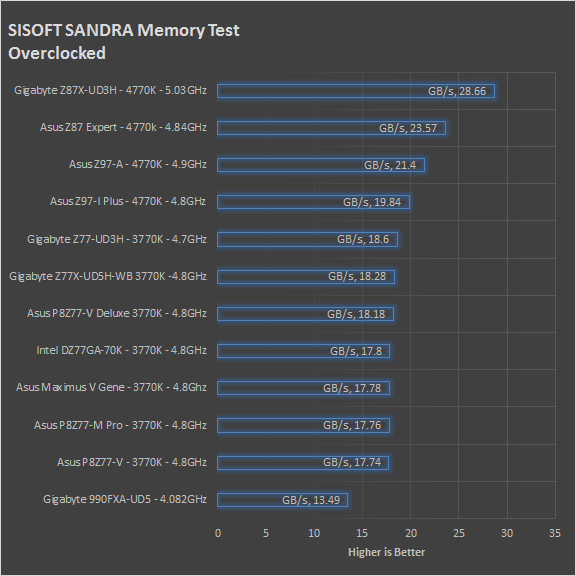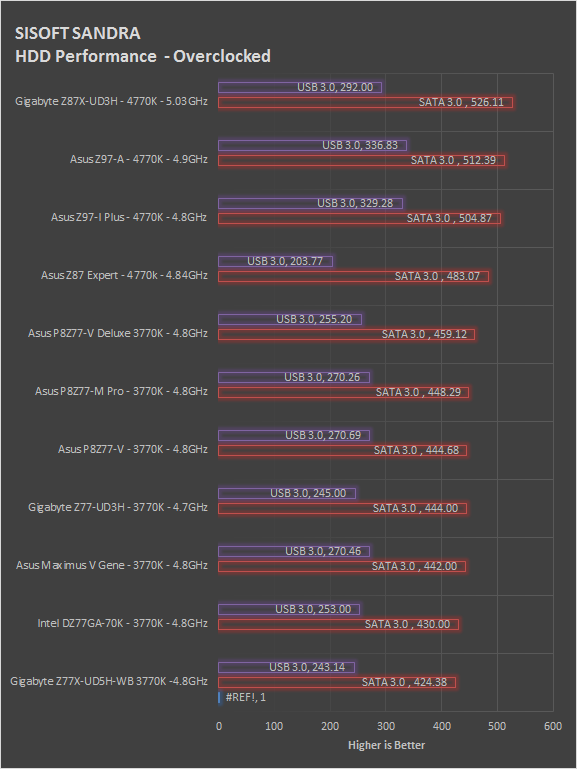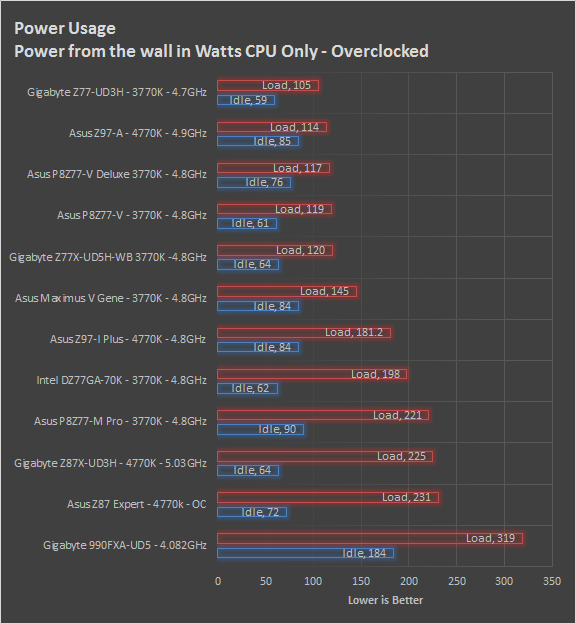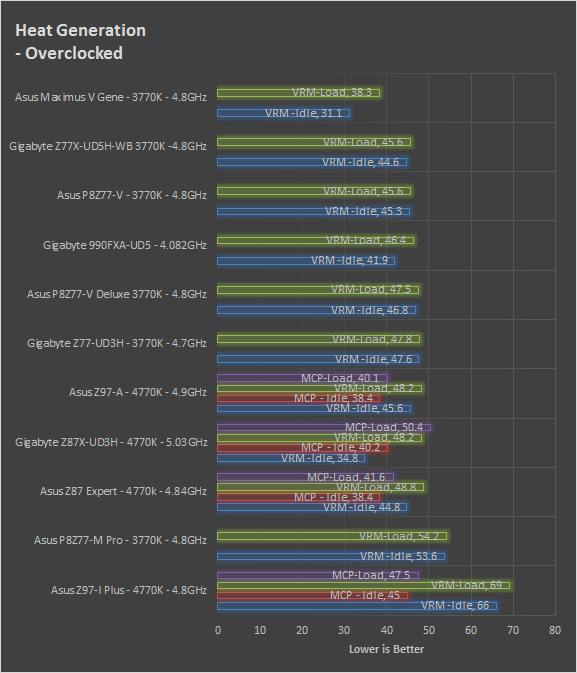Section 1 Subsystems
Memory -
Memory performance is very important on a motherboard, especially when you have a CPU with multiple cores and threads. If you have slow memory your cores and threads can become starved for data to execute. To test memory performance we run both Sisoft’s SANDRA and AIDA64. These two combine to not only give us accurate numbers but to validate each other. For testing at stock speeds the memory is hard set to 16000MHz while overclocking testing is done at the highest stable speed for the voltage of 1.55v this is due to the different memory dividers for each CPU. As such, the memory speeds will vary greatly. This means that the overclocked numbers are a little misleading and while they can show a trend are really only included to show if a board has a problem with memory performance at high clockspeeds. 
The memory performance on the Z97-A is much better than what we saw on the Z97I-Plus. This could be a sign of very good performance later in tests like Lightwave, HyperPi and a few others. Good memory speed can also be important for gaming, image manipulation as well more general purpose usage like web browsing.
Drive performance -
Drive performance is also one of the major subsystems that goes to make up the performance of a motherboard. For our testing we use Sandra and AIDA64 again. We only test with single drives for each type of controller present on the motherboard (unless it is a professional product where we will use RIAD 5 and/or 10). We have also begun using a Thermaltake USB 3.0 dock with another Kingston SCK30/240G 240GB SSD and a Kingston HyperX USB 3.0 Flash drive for our USB 3.0 performance. As a side note, we include the overclocked numbers here to make sure (again) that you are not going to see a major drop in performance due to minor instabilities at high clock speeds.

For drive performance the Z97-A comes in near the top of the list, but ends up being behind its smaller brother at stock speeds and only a little bit ahead when overclocked. You are still getting good drive performance though so this should not be a subsystem that will hinder performance.
Power -
Power efficiency is another of those misnomers that we get caught up in. We hear about idle states and power gates. But what does that mean to you and I? On the surface having power management that reduces idle power sounds great and can be a benefit to someone that leaves their system on for long periods of time (and inactive) but how a system handles power under load and the delta between the two states is often more important than the idle power usage numbers. We use only P3 Kill A Watt instruments for measuring power.

Our power draw tests find a surprisingly efficient motherboard in the Z97-A. After the performance we saw with the Z97-I we did expect to see this board pull much more power, but this was not the case. Even overclocked we did not a massive jump in power draw despite being 100 MHz faster.
Cooling (Board Level) -
Board level cooling is an important factor in product performance and longevity. Components like the chipset, VRM modules and even capacitors need to be kept relatively cool to prevent failure. As these parts are made of silicon, they have a thermal breakdown threshold; or melting point. At that temperature the actual transistors built into chip will begin to deform and break down. Granted, the threshold is often very high, but you still need to make sure that components stay away from this level of heat for longer product life.

The Z97-A does a pretty good job of keeping the important components in the board cool even when we pushed it. You still want to make sure that you have good ventilation in your case though.
Audio -
Audio is highly subjective. What we find pleasing may sound “off” to you. That is always going to the problem with testing audio; results will vary too widely depending on the tastes of the listener. However, there are ways of measuring the audio output with an objective ear. There is also the issue of audio causing performance issues in gaming and video playback. The reason this is a potential source of concern is that all onboard audio CODECs (Compression/Decompression) are CPU controlled. This means that while the audio chip controls the audio levels and effects of the audio the actual work is done on the CPU. Usually this will not be a problem with today’s powerful CPUs. Even the lower and consumer level products can handle high-end audio these days. But again there is the chance that a bad design or software will hinder your system and performance. On the other side the limits of board space, cost, etc will also prevent the level of audio quality you can get from an add-in board. We test all audio parts with three media types, Movie (DVD), MP3 Music, and Gaming. These are pushed to our Tec On model 55 Tube Amp to see if we can detect any signal issues in the reproduction.
Asus has been improving the audio on their more mainstream motherboards. We saw this on the Z97I-Plus and are seeing the same thing happening on the Z97-A. The audio on the Z97-A is not at the same level as the I-Plus, but it is better than many in the same price range.
Networking -
This one is something that is a requirement anymore. If you have a computer, the chances are good (like 99%) that you are also connected to high-speed internet. With this you need a good and solid LAN chip to make sure that your data flows properly out and back.
The networking hardware on the Z97-A is Intel based which typically means you are going to get solid performance. This was a move that Asus made a while ago and we are seeing the rest of the market follow on. We did not encounter any performance issues when running multi-player games, streaming movies, or transferring files.



